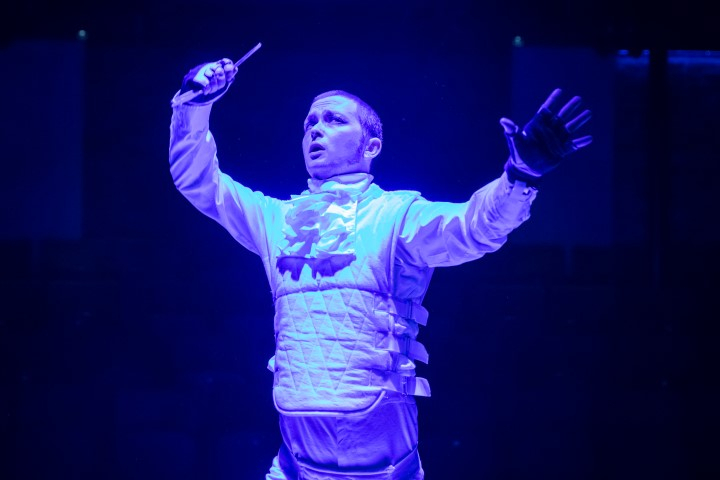Theatre Review: A Clockwork Orange at the Everyman

The script for A Clockwork Orange was first published in 1987, written by Anthony Burgess ‘to stem the flow of amateur adaptations’ that followed the publication of his novel in 1962. Nick Bagnall’s production at the Everyman Theatre, Liverpool, is a slick, shocking and well-executed show, based on Burgess’s script and using his original musical score.
Burgess’s score, written in the music-hall tradition, gives the play a suitably surreal and unsettling feel, with the often upbeat cabaret songs jarring against the ultraviolence that permeates the play. This juxtaposition highlights the sadistic nature of Alex (brilliantly played by George Caple) and his droogs, as they engage in acts of utmost brutality, including a shocking rape, whilst singing in a jovial and playful manner. The only song that is somewhat of an outlier is the more reflective, gentle piece sung by the writer F. Alexander, a character clearly based on Burgess himself.
For most of the pieces, Burgess has borrowed melodies and motifs from Beethoven. Even in the songs that do not reference Beethoven directly, Burgess states that the spirit of the great composer must be present, for Beethoven represents ‘the mature creative mind which can reconcile the creative and the destructive.’ Throughout the play, Beethoven stands as a symbol of what Alex could become, if his youthful energy were channeled towards creation instead of mere destruction.
At some points during the opening scenes the action is obscured by the Nadsat language used by Alex and his gang. Nadsat is the teenage language, primarily a mix of English and Russian, created by Burgess in place of any existing teenage slang, which he rightly predicted would quickly date. Although it takes a little time to adjust to (and Burgess’s writing helps induct us into the weirdness of the voice) Nadsat is what gives both the book and the play their stylised character.
The square stage, in the centre of the room, is well designed: four ladders secured vertically in each corner, connected to one another by beams, creates the effect that the play is happening in a skeletal box – another world into which you are able to see. Secret doors are used well and add another surreal dimension to the production, as characters regularly surface from, and disappear into, the floor. The clever use of ultraviolet light illuminates the white garments of Alex and his droogs, and makes a sinister setting for their ultraviolent acts.
The scenes within the prison are well done, although the appearance of a character dressed as Jimmy Saville is uncomfortable and will touch a raw nerve with some, even if he is subjected to a form of violent justice. The Ludovico aversion therapy is particularly frightening: bloodshot, red-raw red eyes are projected onto the floor beneath a struggling Alex who is straightjacketed and harnessed to the spot.
Burgess’s dislike of powerful institutions, is seen throughout the play and is articulated well in Bagnall’s production: the prison chaplain, performed by Richard Bremmer, frequently delivers sermons on the importance of free will whilst swigging from a bottle of scotch; the Minister of the Interior, a puppet of a man in a pinstripe suit, controlled by a Thatcher-esque woman, cares for nothing except obtaining votes; and the police, given pigs noses and tails, are simply thugs who have moved from a violent, illegal gang to a violent, legal one.
Another victim of ridicule in Burgess’s script is Kubrick. A stage direction at the end of the play, which was removed by Bagnall, states, ‘A man bearded like Stanley Kubrick comes on playing, in exquisite counterpoint, ‘Singin’ in the Rain’ on a trumpet’, before being kicked off the stage. This was the only edition to the original script made by Bagnall, for the understandable reason that this bizarre addition would probably be not be understood by many audience members. However, it does give us an insight into another of Burgess’s motivations for writing the play, which was to write a script that made clear the key themes of the book, which in Burgess’s opinion were obscured by Kubrick’s film.
At its heart, A Clockwork Orange is a Christian allegory about free will. As Burgess states in the preface to the script: ‘Man is defined by his capacity to choose courses of moral action. If he chooses good, he must have the possibility of choosing evil instead.’ In Burgess’s view, this message was lacking in Kubrick’s film, so in the play he repeatedly hammers this point home, primarily through the mouth of the Chaplain, sometimes to the point of spoon-feeding the audience. Burgess also uses the play to emphasise another important aspect of the original book, that in his view had been brushed aside: ‘the capacity of human nature to change’. Thus, in the play, we see the twenty-first chapter, omitted from the film and US editions of the novel, restored, allowing the audience to understand the story in its entirety.
A Clockwork Orange at the Everyman is a must-see, not only for its brilliant and original production, but also because it allows us to experience Burgess’s creation as he intended it.
A Clockwork Orange is on at the Everyman, Liverpool, until Thursday 12th of July 2018.
Photograph by Marc Brenner.


